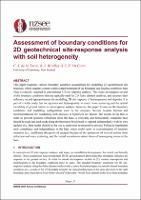| dc.description.abstract | This paper examines various boundary condition assumptions for modelling 2D geotechnical site response, which requires a more sophisticated treatment of the boundary and loading conditions than what is typically required in conventional 1D site-response analysis. This study investigates several of the boundary conditions that are typically used for 2D finite element analyses, and assesses their influence on and appropriateness for modelling 2D site response of heterogeneous soil deposits. It is part of a wider study that incorporates soil heterogeneity to model wave scattering and the spatial variability of ground motion in site-response analysis, however, this paper focuses on the boundary conditions and modelling configuration used in the analyses. Several lessons learned and recommendations for conducting such analyses in OpenSees are shared. The results reveal that in order to prevent spurious reflections from the base, a vertically and horizontally compliant base should be used, and each node along the base must be allowed to respond independently with its own dashpot (i.e., base nodes should not be tied to each other to respond in unison). Failure to implement such compliance and independence in the base nodes could result in overestimation of intensity measures (i.e., inefficient absorption of energy) because of the generation of vertical motion from refraction and wave scattering, and the lateral variation in arrival times of down-going waves at the base. | |

